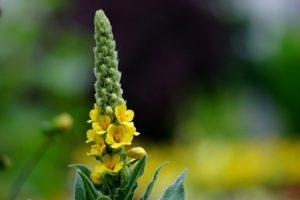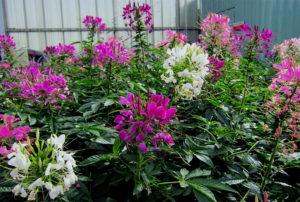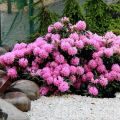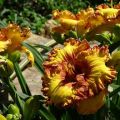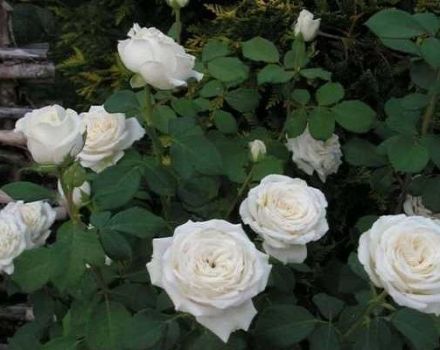Planting and caring for garden buttercups in the open field, growing and storage
Planting and caring for garden buttercups has many features. It is a beautiful ornamental crop with lush bloom. In order for a plant to grow and develop normally, it needs to be properly looked after. At the same time, the culture needs timely watering, fertilization, and loosening of the soil. Protection of plants from diseases and pests is of no small importance.
Description
The garden buttercup is a herbaceous perennial crop that can grow up to 63 centimeters in height. The plant is characterized by a fleshy tuberous rhizome and a leafy branchy stem. The foliage has a triple-dissected shape. In appearance, it resembles dahlia leaves. Flowers reach 8-10 centimeters in diameter. They can be plain, double or thick double.
The inflorescences are characterized by bright shades - white, pink, red. There are also cream, yellow, orange. These plants come in almost all colors. The exceptions are blue and blue buds. You can also find two-tone varieties. When cut, the flowers stay fresh for a long time. They can stand in a vase for at least a week. However, despite its many advantages, the plant has poisonous properties. Therefore, it is recommended to keep it away from animals and children.
Beneficial features
Garden buttercups have many beneficial properties. In addition, they are distinguished by their decorative appearance. That is why the culture has gained great popularity among gardeners.
Decorative
The plant is often used for decorative purposes. It is suitable for decorating flower beds, plots, lawns. It can also be grown in a flower pot at home. The varied palette of plant shades allows you to create stunning compositions.At the same time, buttercups can be safely combined with any flowers. The plant is popular with landscape designers and florists. It is often chosen by flower growers and people who are engaged in the decoration of holidays.
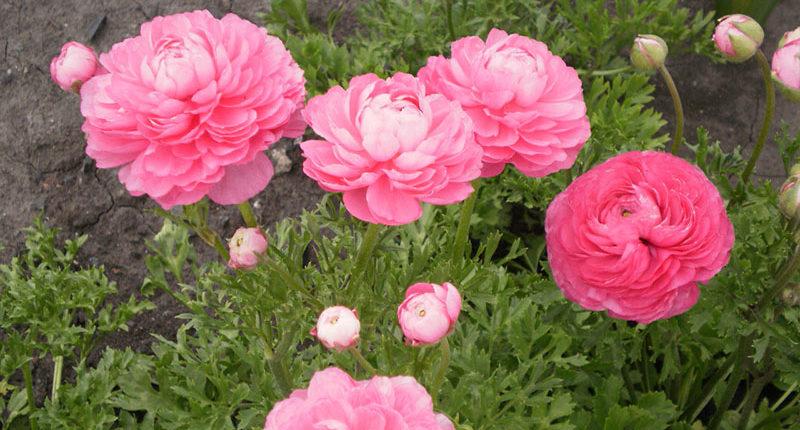
Therapeutic
Almost all types of buttercups contain many valuable ingredients. These include the following:
- Protoanemonin. This substance has tonic properties and activates the nervous system. It helps to strengthen the immune system, cope with pathogenic bacteria and increases the hemoglobin content in the blood.
- Coumarins. They are natural anticoagulants that accelerate the regeneration processes in cells and are a source of vitamin P. It helps prevent blood clots from forming.
- Cardiac glycosides. These substances normalize the work of the heart, cope with tachycardia, stimulate blood flow and reduce blood pressure.
- Saponins. Substances have choleretic characteristics and reduce temperature. They also help to normalize blood pressure, thin phlegm, and improve reproductive functions.
- Tannins. They narrow and strengthen the walls of blood vessels, provide protection for the mucous membranes of the digestive system and skin.
- Alkaloids. These components activate the functions of the immune system, have a tonic effect, cope with heat and pain, and reduce pressure parameters. Also, substances strengthen the walls of blood vessels, stop bleeding and disinfect wounds.
- Flavonoids. These components prevent the destruction of hyaluronic acid, activate metabolic processes, make the walls of blood vessels more elastic, neutralize the action of free radicals and prevent sclerotic processes.
- Vitamin C. The substance takes part in the immune system and normalizes the function of hematopoiesis.
- Carotene. The component helps to improve visual function, strengthens bone tissue, and improves the condition of teeth. It also normalizes skin elasticity and strengthens hair. With its help, it is possible to slow down the aging process.

Buttercup species
There are many varieties of garden buttercups, each with specific characteristics.
Classical
Currently, the genus of Buttercups includes more than 400 plant species. Moreover, this list is constantly growing.
Pungent
This plant is also called night blindness. It is a herbaceous perennial crop that reaches a height of 20-50 centimeters. It includes straight, branched shoots. The leaves of the plant are located along the entire height of the branches, but quite rarely. On the bottom, they are larger and are practically solid. The upper leaves are strongly dissected and have linear lobes. In June, simple yellow flowers with 5 wide petals appear. Their diameter is no more than 2 centimeters.
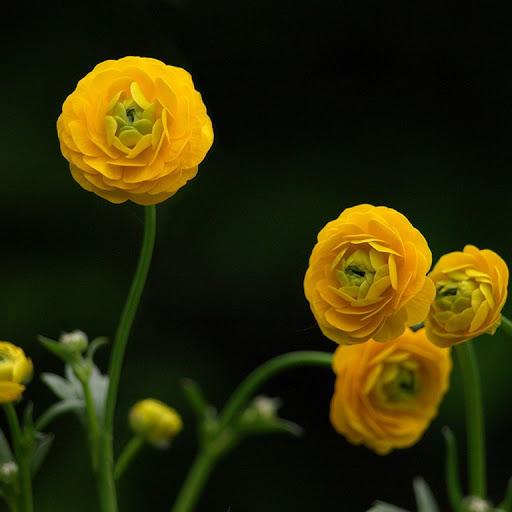
Golden
This plant is often found in damp shady meadows and reaches a height of 40 centimeters. Straight stems contain practically no leaves. The root rosette consists of rounded toothed leaves on long petioles. On top are linear sessile leaves.
The plant has small yellow flowers with a pubescent calyx and a simple bell-shaped corolla. They appear in April and June.
Creeping
This perennial culture is characterized by lodging stems 15-40 centimeters high. They easily take root in the nodes upon contact with the ground. The stem of the plant is covered with short villi. Petiole leaves are bright green in color and are located along their entire length. The flowers are regular in shape and yellow in color. Their structure includes 5 petals. The buds bloom in the first half of summer.
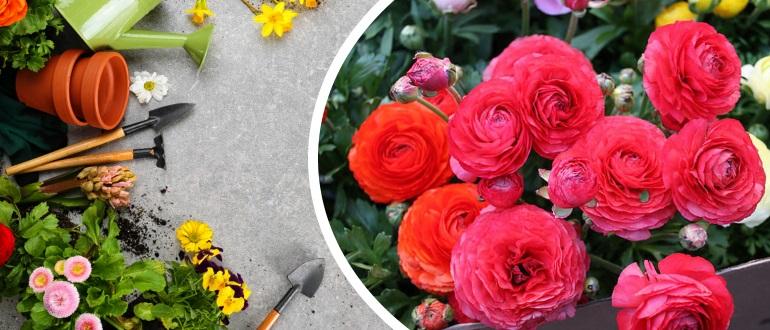
Poisonous
This plant can be perennial or annual. It has a branched straight stem and reaches a height of 10-70 centimeters. The shoots are decorated with openwork trifoliate leaves. They are characterized by jagged edges. The ovoid lobes of the plant stand out with a dark green tint.In late spring or early summer, small flowers appear on the bushes. They are light yellow in color.
Asiatic
This culture has decorative double flowers that resemble roses in appearance. The plant is a semi-shrub that reaches a height of 40 centimeters.
Burning
It is a perennial crop that has a bare or straight stem. It can reach 20-50 centimeters in height. The leaves of the plant are oval or diamond-shaped. From below, the leaves are attached to the shoots with long stalks, from above - they are located directly on the stem. The culture has small flowers that reach 1 centimeter in diameter. They are solitary and yellow. The plant has a poisonous sap and can provoke irritation on the skin.
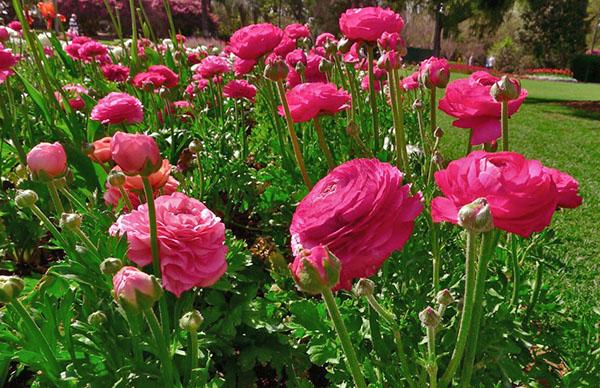
Water
This plant has creeping shoots and is small in size. In height, it reaches 5-20 centimeters. Straight petioles are decorated with carved leaves that resemble snowflakes in appearance. The culture has excellent decorative properties. It is often used to decorate aquariums.
Multi-flowered
It is a herbaceous perennial plant that grows up to 40-80 centimeters. It includes straight branched stems covered with short villi. Finger-dissected leaves have fluff. From June to August, simple flowers appear on the bushes. They have a rich yellow tint.
Sayansky
This plant has curved shoots 20-30 centimeters high. It is characterized by rounded leaves. They can also be heart-shaped. With the arrival of summer, the bushes are decorated with single flowers. They are yellow in color and have a hairy receptacle.
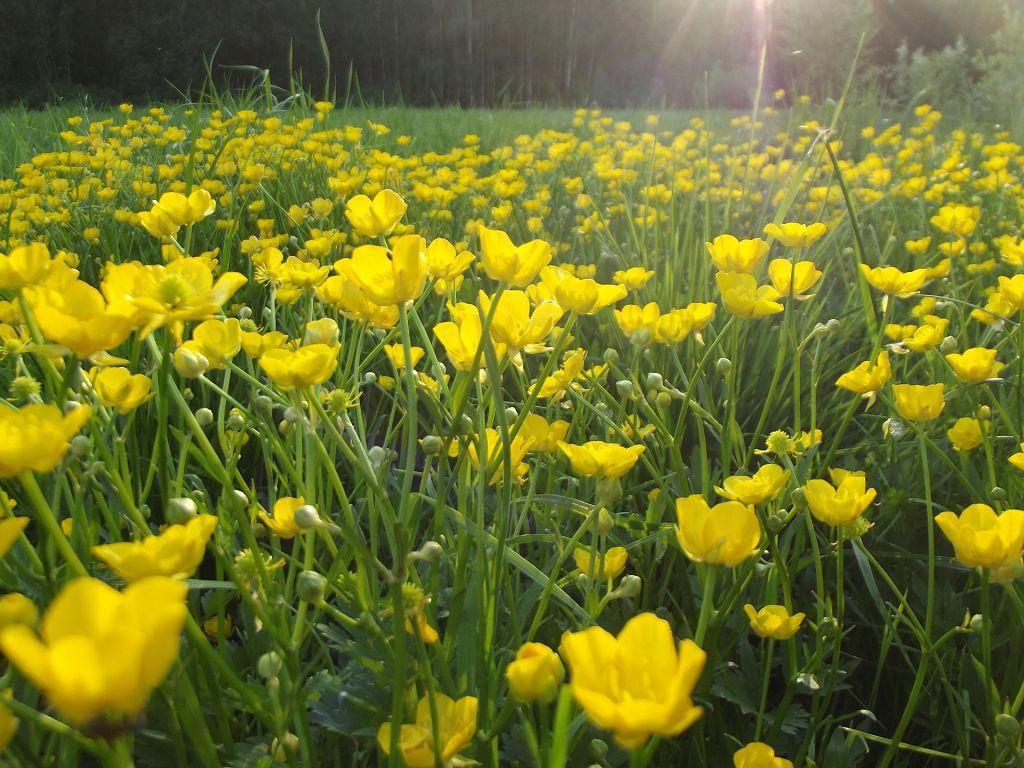
Kashubian
This perennial is characterized by a straight stem. It branches only from above. Plant height is 30-60 centimeters. The leaves have a solid structure and are round or heart-shaped. Flowers are localized singly and have a light yellow color. Flowering begins in April.
Snowy
This culture reaches a height of 6-15 centimeters. It is decorated with single dark yellow flowers that appear in July and August. The plant prefers moist places. It can often be found in swampy areas.
Ornamental garden
This culture has a beautiful appearance and many varieties. Each of them has certain features.
Masha
It is a compact bush that has a branched stem and reaches 30-40 centimeters. Terry buds of the plant have white petals and a rich color border.
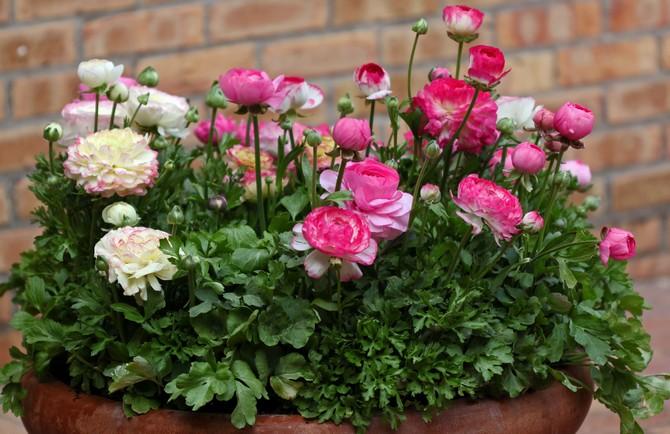
Terry
It is also called peony. The plant is characterized by large flowers with closely spaced petals.
French
This variety is characterized by semi-double flowers. Their structure includes 2-3 rows of wide petals.
Persian
This culture has small flowers. They can be plain or semi-double.
Chalmoid
The plant is decorated with dense double flowers. They have a spherical shape.
Red Book
Quite a few buttercups are listed in the Red Book. These plants differ in appearance and properties.
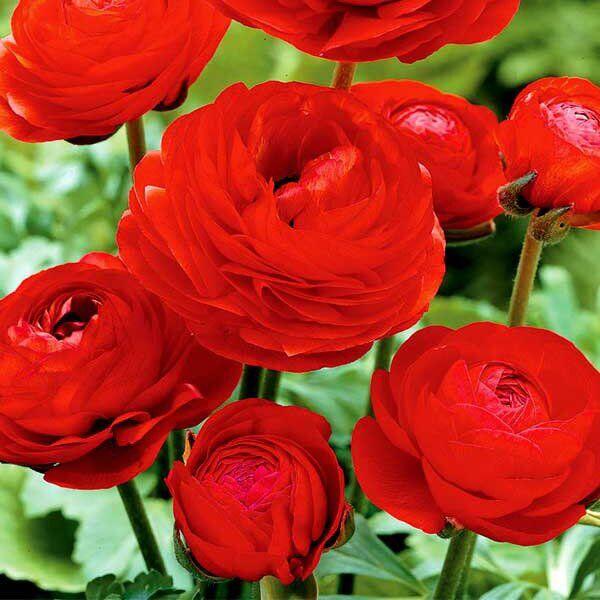
Long-leaved
This is a fairly bright plant that has yellow flowers. It is a spectacular perennial, characterized by root buds extending from unusual nodes and underground shoots. The plant has large stems. Their height is 0.5-1.5 meters.
Northern
A perennial plant reaches a height of 20-40 centimeters. It is characterized by a fibrous root and a straight stem. The branches reach 1.5-2 centimeters in diameter. The flowers of the plant are yellow.
Popular varieties
Garden buttercups have many interesting varieties. This allows each grower to choose the best option for planting in his area.
Pearl Pikoti
This culture is characterized by white petals.At the same time, through them you can see a bright purple dusting.
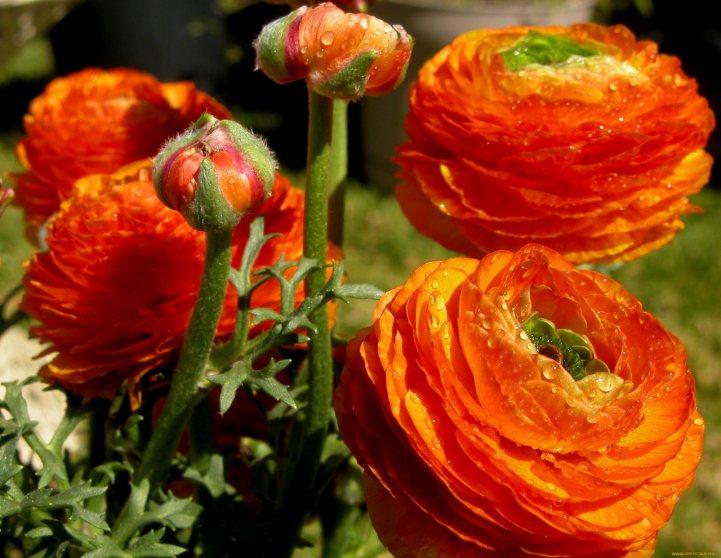
Bloomingdale Rose Bicolor
This plant has white flowers with a pale pink border.
Double Pink Buttercup
The culture has dense double flowers. Their petals fit tightly to each other.
Mixed
Today on sale there are mixtures with seeds of different plant species. As a result, it will be possible to get a whole mix of multi-colored buttercups.
Gold Rose
This plant has yellow flowers. The bushes reach a height of 30 centimeters.

Features of planting in open ground
In order for the plant to develop normally, it is worth paying attention to the correct carrying out of planting work.
Soil preparation
Fertile and well-drained soil, which contains a lot of humus, is suitable for culture. As for the acidity parameters, the earth should be neutral. A slightly acidic soil is also suitable.
Buttercups grow well in moist soil. Therefore, they should be planted in areas with a surface location of groundwater. In this case, a full-fledged drainage layer is of no small importance.
It is recommended to plant garden buttercups in small groups, which helps to achieve the maximum decorative effect of the beds. From autumn it is recommended to dig up the soil for plants. In this case, compost and manure will have to be added to its composition.
Preparing planting material
No special preparation for planting material is required. To improve seed germination or survival of seedlings, they can be treated with a growth stimulant before planting.
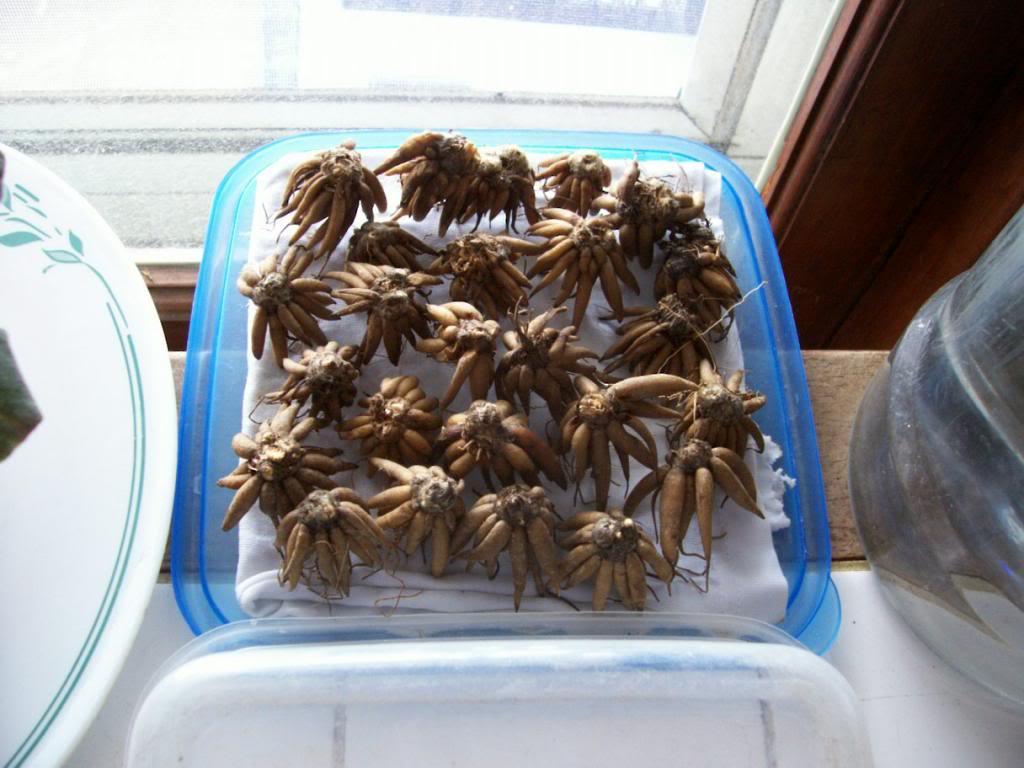
Choosing a place and time of boarding
It is recommended to plant garden buttercups in well-lit areas that are protected from direct sunlight and wind. Excess sun will lead to seed problems. It also prevents long-term flowering. It is better to carry out planting work in the spring. Autumn is not exactly the right time for this. The plant should be planted from late April to the second half of May. It is important that the soil warms up well.
How to plant correctly
For planting work, it is recommended to do the following:
- Dig small indentations for planting. In heavy soil, their depth should be 3-5 centimeters, in light - 6-8.
- The distance between the bushes should be 10-15 centimeters.
- Place a drainage layer on the bottom. It should include sand and expanded clay.
- Place the plants in the grooves and cover with soil. Tamp and water the soil from above.
- Place the tubers in the holes. It is recommended to do this with the roots down.
- After completing planting work, cover the bed with a mulch layer.
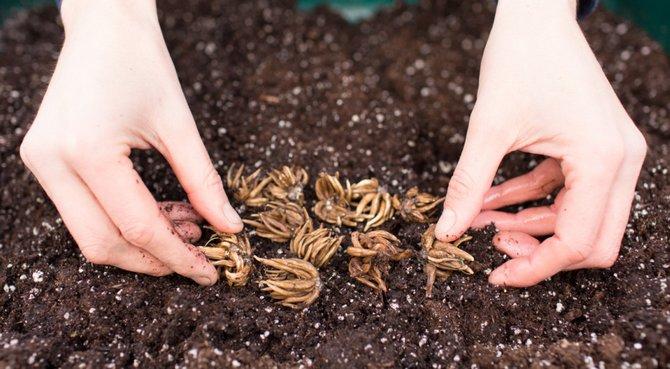
When planting garden buttercups in a seedling way, it will be possible to wait for the flowering of the bushes only next year.
Care features
In order for the culture to fully develop and flourish, it is recommended to provide quality care.
Watering
The culture is very demanding on the composition of the soil. She can hardly tolerate excessive watering or too dry weather. It is recommended to control the condition of the soil so that it does not dry out. It is recommended to water the plants when the top layer dries. In this case, it is worthwhile to moisturize the bushes carefully. Otherwise, there is a risk of root rot.
After the end of flowering, the number of waterings should be reduced. During this period, the plants begin to prepare for the dormant period, so they do not need food. After the foliage turns yellow, it is recommended to completely abandon watering.
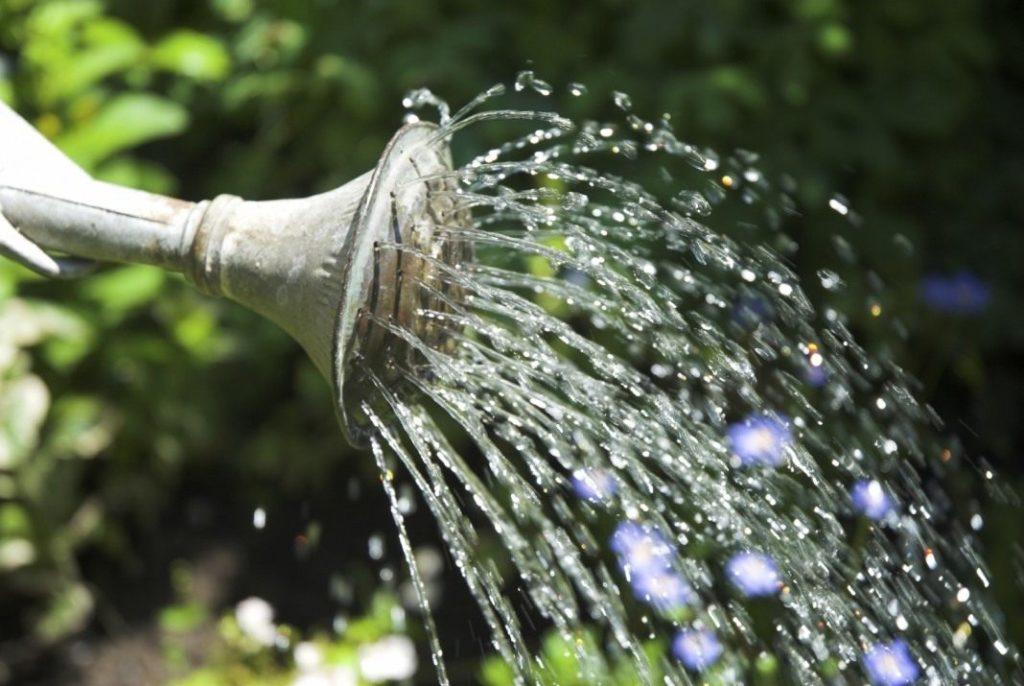
Drainage
To protect the planting from excess moisture, it is worth placing a drainage layer in the grooves. It can include pebbles or expanded clay.
Weeding and loosening
The soil around the bushes should be constantly loosened. Removal of weeds, which absorb nutrients and moisture, is of no small importance.
Top dressing
During the entire growing season, flowers need adequate nutrition. In this case, it is recommended to add organic matter or complex products. This is done at intervals of 10-14 days.During the period of leaf development, it is worth using nitrogen-based products. When flowers appear, the bushes require phosphorus and potassium.
Digging and storing tubers
Many types of buttercups have to be dug up for the winter. This procedure is carried out in late summer or early autumn - after the death of leaves and stems. If the tubers are not dug out in time, the rhizome will begin to grow. When digging out buttercups, it is important to consider that they have fragile roots, so the procedure should be performed very carefully.

After this rhizomes are recommended to be washed. If they have grown too much, divide them. Then the tubers are recommended to be washed with fungicides or potassium permanganate and dried. It is worth keeping the tubers in sawdust, sand or peat. At the same time, maintain the temperature in the room + 4-6 degrees.
It is recommended to inspect the rhizomes every month. This will help to timely identify pathologies and avoid their spread. If symptoms of rot or mold appear, it is recommended to remove the affected tubers. With a small lesion, it is permissible to treat them with colloidal sulfur.
Pinching, pinching and trimming
In order for the plant to bloom for a long time, it is recommended to remove dried branches in time. Timely pruning helps to make the shrub more beautiful. However, he will be able to bloom until August. During the development of buttercups, it is recommended to get rid of dry leaves and faded buds. With the arrival of autumn, dead flower stalks are completely removed.

Mulching
This procedure helps to avoid moisture evaporation. It also protects the beds from weeds. Peat, sawdust, dry grass or leaves can be used as mulch.
Wintering
Outdoors, a garden buttercup won't survive the winter. After the flowering period is over, all terrestrial fragments will die off. It is recommended to dig up the tubers at this point.
After flowering
After flowering is complete, you will have to gradually reduce the number and frequency of watering. When the leaves turn yellow, the moistening of the soil must be completely stopped. In August or September, you should start digging up the tubers.
Features of growing at home
Buttercups are perfectly acceptable to grow at home. At the same time, it is recommended to strictly adhere to the main agrotechnical recommendations.
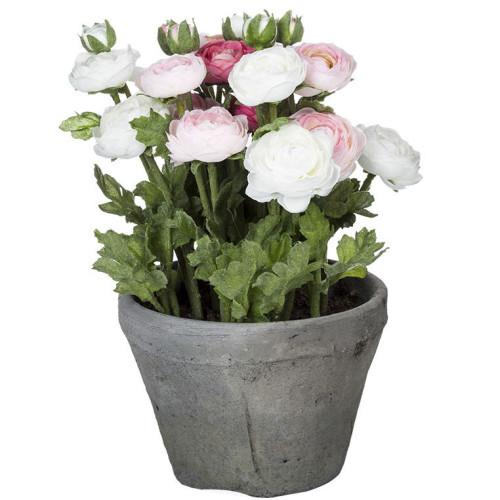
Pot selection
Tubers of this culture are best planted in small pots. Individual glasses are also suitable for this purpose.
How to choose soil
Buttercups require lightweight and breathable soil. Too dense soil will inhibit germination and make it difficult for nutrients to reach the tuber. It is best to use humus and black soil for planting crops. It is also permissible to introduce a small amount of sand into the substrate. It is recommended to make drainage holes in pots.
Tuber preparation
You will have to put a rag or napkin in the container. Then moisten it with a solution of fungicide or growth stimulant. Top with buttercups tubers and cover with a dry napkin. It is recommended to cover the container with a film. After swelling of the planting material, it is allowed to pull it out. This usually takes 1-3 hours.
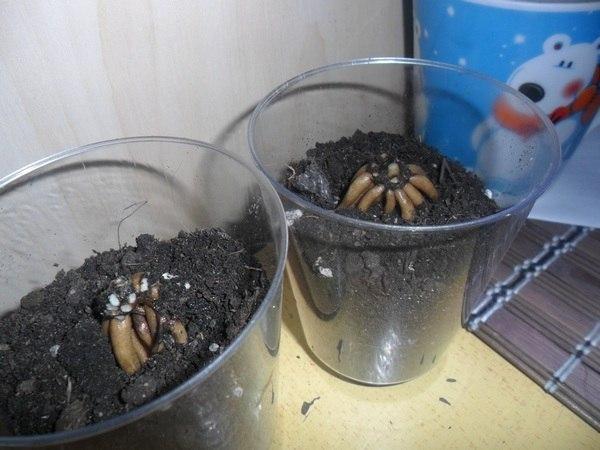
Drainage
To avoid rotting of the root system, it is important to properly organize the drainage layer. It can include crushed bricks or pebbles.
How to plant
It is recommended to plant tubers to the depth of their height. This means that only the top should remain on top. After that, the tubers should be sprinkled with earth 2-3 centimeters and sprinkled with Fitosporin solution.
Watering
You will have to moisten the plant as the substrate dries out. It should be borne in mind that there is no need to transfuse the culture.
Temperature
In order for the culture to develop normally, it needs a low temperature at the level of + 16-18 degrees. The increased dryness of the air and the temperature above +25 degrees will lead to the death of the plant.
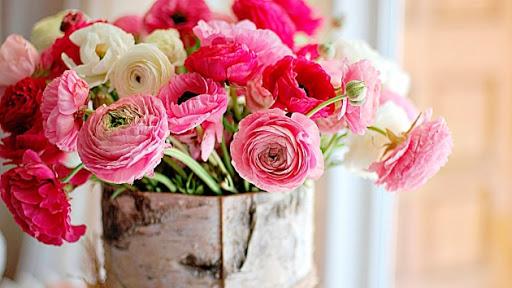
Top dressing
It is recommended to feed the plant with minerals and organics.Potash products, peat are perfect. It is also permissible to use compost solution. For good results, feeding should be alternated.
Reproduction methods
It is permissible to propagate a plant by 2 methods - by seeds or by dividing. The second method is considered to be simpler and more effective.
Seminal
The seeds are sold in specialty stores. It is also permissible to collect them yourself. To do this, after the flower withers, the box should be tied with gauze. When the fruit is dry, it is recommended to lightly press down on it and pour out the seeds. After that, carefully remove the gauze with planting material and dry in a warm place. Then transfer the seeds to paper bags and store them.
It should be borne in mind that buttercups grown in this way will not take varietal characteristics, therefore it is better to use store seeds. It is better to plant seeds in seedling boxes or in open soil. In the first case, planting work should be carried out in February, in the second - in May.

Rhizome division
In autumn, it is recommended to dig the tubers out of the soil and carefully separate the fresh growths. Treat damaged areas with charcoal. Then dry the fragments and treat them with a fungicide. Store them at a temperature of + 10-12 degrees. With the arrival of spring, soak the tubers, and plant them in the ground at the end of April. They are deepened by 7-8 centimeters.
Diseases and pests
The culture is distinguished by a fairly strong immunity, therefore it is practically not susceptible to dangerous fungi. However, sometimes such problems do arise. In such a situation, fungicides are used.
Root rot
The development of pathology is due to improper watering. Root rot usually develops with excess moisture.
Powdery mildew
This violation is associated with high air humidity and high rainfall. Bordeaux liquid will help to cope with it.
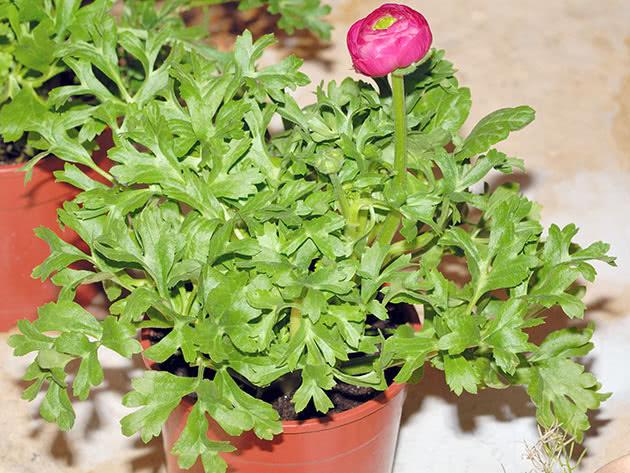
Cabbage butterfly
Larvae and caterpillars of butterflies provoke damage to leaves and shoots of bushes. When these pests are identified, there is a need for the use of bioinsecticides.
Nematodes
Infection of the root system with nematodes can be suspected by weak growth and twisting of leaf plates. In such a situation, the bush will have to be dug out, its roots removed from the soil and lowered into warm water.
Fungal diseases
High-quality soil drainage will help to avoid fungal infections. Compliance with the irrigation regime is of no small importance. With the development of fungi, remove the affected fragments, and treat the bush with a fungicide.
Use in landscape design
Buttercups have excellent decorative properties. Therefore, they are often used to decorate garden plots.

Combination with other cultures
This flower goes well with other crops. It can be planted in the same bed with cornflowers, bells, hosts. Evergreen shrubs will be great additions.
Garden decoration
Garden buttercups perfectly complement mixed flower beds. Depending on the height of the bushes, they are allowed to be planted in the foreground or in the center of the flower garden. Also, these plants are suitable for decorating alpine slides, mixborders, rockeries. Some varieties are often grown in pots.
Prevention
To prevent the plant from encountering dangerous diseases or parasites, timely preventive treatments will have to be carried out. White mold is considered one of the main threats to the culture. It provokes the defeat of the peduncles and leaves of the culture.
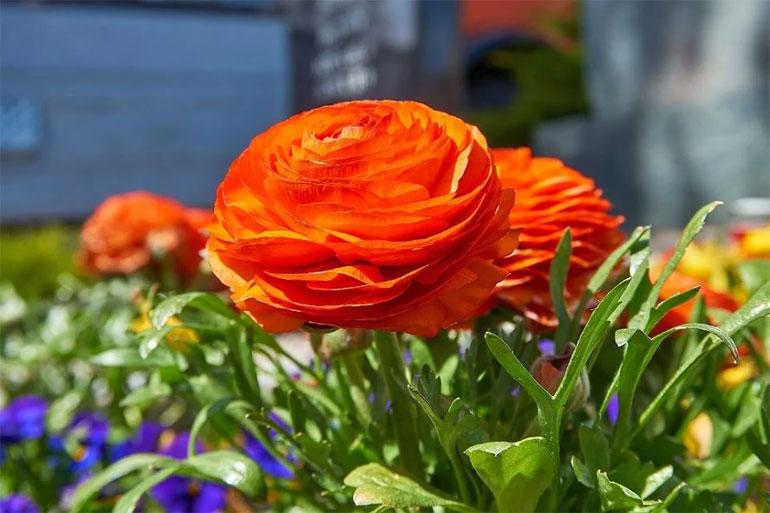
Garden buttercups sometimes encounter fungal diseases. The appearance of problems is indicated by the formation of brown spots. They are localized on the leaves and their petioles. One of the most dangerous plant pests is a nematode. It provokes root damage. There is also a risk of spider mite attacks. In this case, the leaves curl up, the growth of the bush is disrupted. The foliage is covered with yellow or silvery spots.In order for the plant to develop normally, it is recommended to provide the correct prevention. In this case, it is worth doing the following:
- Establish an irrigation regime. It is not recommended to use too much moisture. With excessive watering, there is a risk of developing powdery mildew.
- The very first symptoms of problems should be the basis for a complete cessation of watering.
- To avoid stagnant moisture, it is recommended to loosen the soil on time, organize high-quality drainage and use insecticides.
- To cope with the nematode, treat the roots of the bushes once with a solution of potassium permanganate.
- It is better to use acaricides to kill spider mites.
Answers on questions
When to dig up and how to store the bulbs? This procedure is recommended to be performed in the fall, immediately after the death of the ground part of the plant. If the tubers are not dug up in time, there is a risk of their germination. They should be kept cool until next spring.
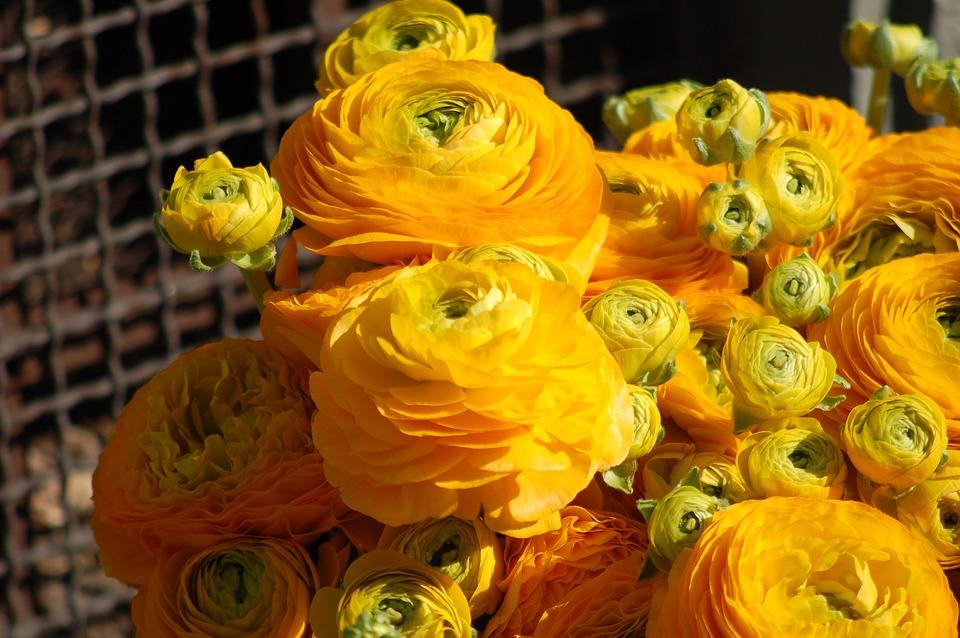
How often is it recommended to water the plant? This should be done as the topsoil dries out. With an excess of moisture, there is a risk of root rot and the development of fungal diseases.
Do I need to cover the bushes for the winter? This culture is not able to withstand the winter outdoors. Therefore, after the leaves and branches die off, the tubers will have to be dug up.
Reviews
A lot of reviews about this culture testify to its popularity:
- Victoria, 42 years old: “Garden buttercups look very beautiful and cheerful. I really like the variety of their shades. I created a real composition of these flowers on my site. The only drawback I can name is the need to dig up tubers for the winter. They simply cannot withstand the extreme drop in temperature. "
- Marina, 38 years old: “I have been growing this crop on my site for a long time. I can say that buttercups are not particularly demanding to care for. To avoid the development of fungi, it is necessary to carry out prevention on time. Controlling the frequency of watering is also important. The rest of the buttercups are absolutely unpretentious. "
Garden buttercups are a popular culture that can decorate any site. In order for the plant to develop normally and please with lush and long flowering, it is recommended to properly care for buttercups. At the same time, it is necessary to water, feed the bushes in a timely manner. Protection of buttercups from diseases and pests is also important.
